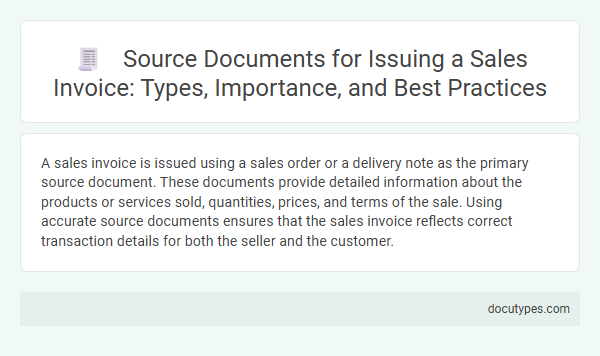A sales invoice is issued using a sales order or a delivery note as the primary source document. These documents provide detailed information about the products or services sold, quantities, prices, and terms of the sale. Using accurate source documents ensures that the sales invoice reflects correct transaction details for both the seller and the customer.
Introduction to Source Documents in Sales Invoicing
Source documents are essential records that initiate the sales invoicing process by providing accurate transaction details. Common examples include sales orders, delivery notes, and purchase requests, which verify the sale and provide critical data for invoice generation. Understanding the role of source documents ensures the accuracy and legitimacy of sales invoices in business accounting.
Definition and Role of Sales Invoices
A sales invoice is a commercial document issued by a seller to a buyer, detailing the products or services provided along with their prices and payment terms. It serves as an official request for payment and a record of the sales transaction.
The source document commonly used for issuing a sales invoice is the sales order or delivery note, which verifies the goods or services delivered. This document ensures accuracy and accountability in billing, linking the invoice to the actual sale events.
Common Types of Source Documents for Sales Invoices
| Source Document | Description | Role in Issuing a Sales Invoice |
|---|---|---|
| Purchase Order (PO) | A formal request from a customer specifying items, quantities, and agreed prices. | Serves as the initial agreement that triggers the invoicing process based on confirmed orders. |
| Sales Order | Document created internally to confirm the details of a sale after receiving a purchase order. | Acts as a verification tool ensuring that your sales team processes the correct product and quantity before invoicing. |
| Delivery Note or Dispatch Note | Proof of goods shipped or delivered to the customer with details such as quantity and description. | Used to confirm the actual delivery of items, validating the sales invoice data. |
| Sales Receipt | A document that confirms the payment has been received for goods or services. | May be referenced during invoicing to ensure accurate recording of transactions and balances. |
| Return or Credit Note | Issued to adjust or correct previous invoices due to returns or discounts. | Helps maintain accurate invoice records by modifying amounts owed as necessary. |
Purchase Orders: Foundation of Sales Transactions
A sales invoice is typically issued based on a source document that initiates the sales transaction process. Purchase orders serve as the fundamental source document for creating a sales invoice by detailing the buyer's request.
- Purchase Orders Define Transaction Details - They specify product types, quantities, and agreed prices that form the basis for the sales invoice.
- Purchase Orders Verify Buyer Intent - They confirm the buyer's commitment to purchase, enabling accurate invoice generation.
- Purchase Orders Facilitate Order Tracking - They provide a reference for both buyer and seller to ensure fulfillment aligns with the original request.
Sales invoices generated from purchase orders enhance accuracy and transparency in sales transactions.
Delivery Receipts and Goods Dispatch Notes
The source document used for issuing a sales invoice is crucial for verifying the delivery of goods. Delivery Receipts and Goods Dispatch Notes serve as key records confirming the shipment and receipt of products.
- Delivery Receipt - This document provides proof that goods have been delivered to the customer, detailing items, quantities, and delivery date.
- Goods Dispatch Note - It authorizes the shipment of goods from the warehouse, specifying the quantity and description of items dispatched.
- Source Document Role - Both documents ensure accurate and accountable invoicing by recording the physical transfer of goods to the customer.
Sales Contracts and Agreements
What source document is used for issuing a sales invoice? A sales contract or agreement serves as the primary source document for issuing a sales invoice. This contract outlines the terms of the sale, including product details, prices, payment terms, and delivery schedules, ensuring accuracy in the invoice generation process.
Importance of Accurate Source Documentation
Source documents such as sales orders or delivery receipts are essential for issuing a sales invoice. Accurate source documentation ensures the correctness of billing details and facilitates smooth financial record-keeping.
- Sales Order - Acts as the initial agreement detailing the products or services purchased, quantity, and price.
- Delivery Receipt - Confirms the physical transfer of goods to the customer, validating the invoice's accuracy.
- Importance of Accuracy - Prevents billing errors, supports audit trails, and maintains reliable accounting records.
Legal and Compliance Considerations
The source document used for issuing a sales invoice is typically a sales order or delivery note, which serves as proof of the transaction between buyer and seller. This document must contain accurate details such as product descriptions, quantities, prices, and buyer information to ensure legal compliance.
From a legal perspective, the sales invoice must comply with tax regulations, including the correct application of VAT or GST as required by jurisdiction. Compliance also involves maintaining audit trails and ensuring the document is stored securely for the required period as mandated by law. Failure to use proper source documents can lead to penalties, disputes, and challenges during tax audits.
Best Practices for Managing Source Documents
The primary source document used for issuing a sales invoice is the sales order or delivery note. These documents provide detailed information about the products or services sold, ensuring accuracy in invoicing.
Best practices for managing source documents include maintaining clear, organized records and verifying all details before issuing the invoice. You should store source documents securely to facilitate audits and resolve any discrepancies efficiently.
What Source Document Is Used for Issuing a Sales Invoice? Infographic

